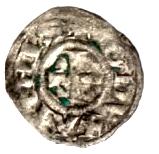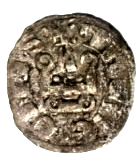 Obverse
Obverse
The grading system runs on a scale from:
Poor - Good - Very Good - Fine - Very Fine - Extra Fine - Fleur de Coin (Uncirculated).
Thus a coin that is listed as "very good" is actually pretty bad, and "good" coins are absolute crap! Don't even think about what a "poor" coin is like. Generally it will be semi-circular scrap of metal that may or may not have been a coin at one time or another in the past couple thousand years. One dealer/collector told me that any medieval coin where you can read the legend is automatically considered at least Fine, and this is as good a rule as any.
I generally try to get coins that are at least in Fine condition. The Good to Very Good coins that I have are ones that I have picked up as unattributed coins in a dealer's "bargain box". They are coins that require a bit of sleuthing to identify. Parts of the legend may or may not be legible and the coins are generally quite worn and damaged. However, the styles and denominations are generally pretty distinctive from region to region and it's generally pretty easy to figure out what a partially legible legend is supposed to say with a few hours of detective work. But the people selling these coins can't invest a couple hours of their valuable time on a junky coin that might never sell. That's where my fun begins.
In the coin below for example, the obverse side is supposed to read + G DUX ATENIS. To begin, most of the legends on
medieval coins start with a cross. As you can see below, there is a cross at the 5 o'clock position, however it is cocked to the
side which makes it an "X". A closer examination shows a mostly smashed cross at the 12 o'clock postion. At 3 o'clock is a
very legible "D" and at 6 is an "A". (Medieval engravers were a lazy bunch, so the A is really an inverted "V" with a bar on
top.) The next couple of letters are kind of smashed but the 3rd, 4th, and 5th ones (at 9, 10, and 11 o'clock) are clearly either
an "H" or an "N" followed by an "I" and an "S". Thus far we've identified + _D_X A_ _ (H or N)IS.
 Obverse
Obverse
From this point I have
to make some deductions. The first part is most likely going to be some form of "DUX" (duke) as there are no other words
with that combination of letters. The second part is a little tricker. Medieval engravers were not literary geniuses, so their
spelling varies greatly, and if they ran out of room they would abbreviate at will. About the only thing you can count on is that
the word will start with the right letter - thus in this case both Achaea and Athens are likely candidates. Having narrowed it
down to those two suspects, I can look at the reverse and see if there is a match. Sure enough, the Athens explanation fits -
while it's difficult to read the legend outright, it's easy to see "THEBE CIVIS" if I know what to look for. This means that the coin was minted in Thebes, a city near Athens. "DE CLARENTIA"
(which means "of Glarentza") would be the Achaea explanation and it just doesn't fit. Then I look closely at the diagrams in the reference books to see if
the letters correspond and if the smashed or missing ones are remotely similar and identify the coin.
 Reverse
Reverse
Continue the tour - A comparison of different grades of Medieval coins
Click here to visit Doug Smith's website that details how to grade ancient coins.
![]()
![]()
![]()
![]()
![]()